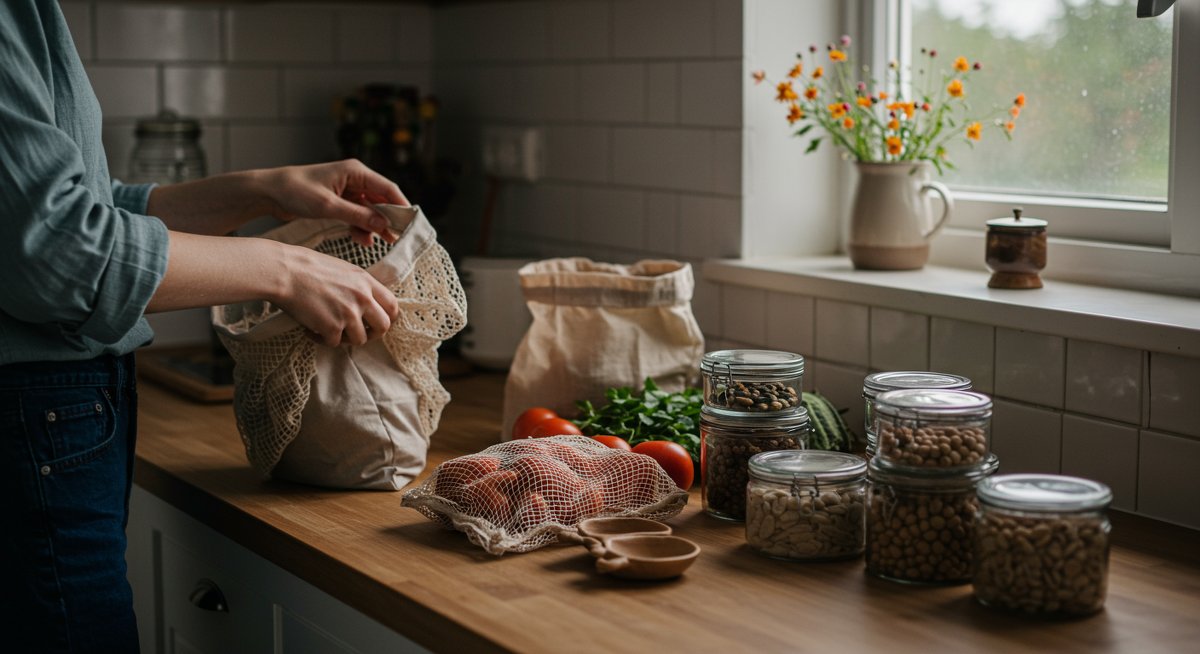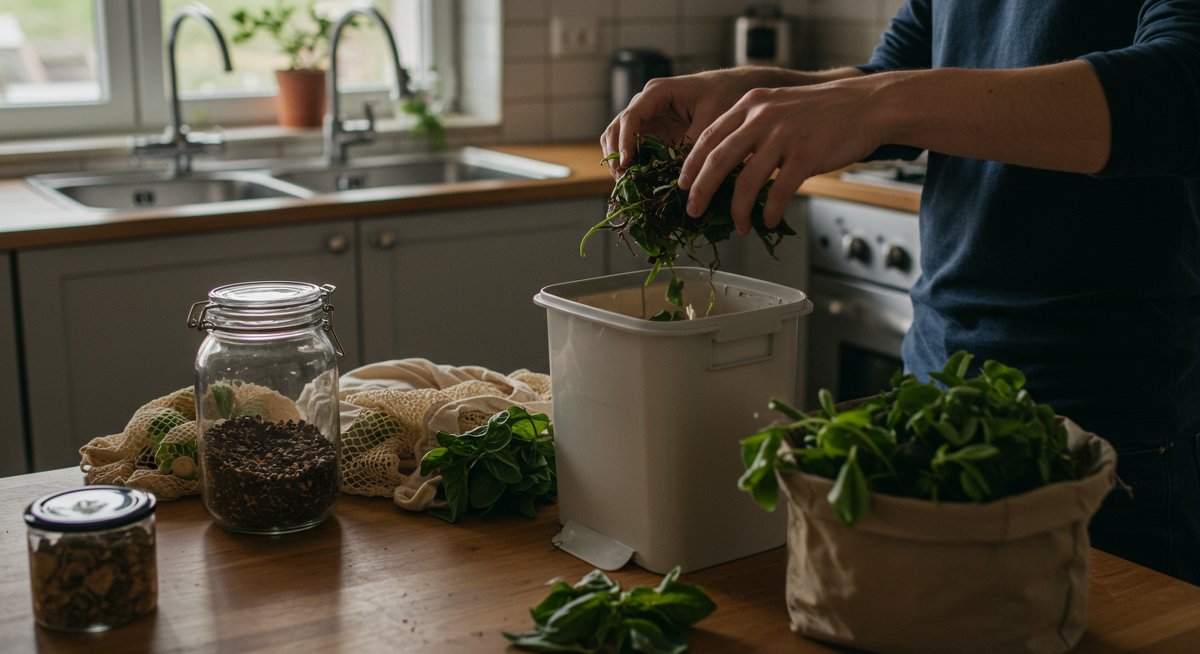Are you ready to embrace a greener lifestyle without emptying your wallet? Sustainable living doesn't have to be expensive or complicated. This guide is your easy entry point into the world of eco-conscious choices, showing you how to reduce your environmental impact while saving money in 2025. We'll explore simple swaps, smart habits, and practical strategies that make sustainable living accessible to everyone.

Why Embracing Budget-Friendly Sustainability Matters for a Greener Life
Choosing a sustainable lifestyle is no longer a niche trend; it's a necessity for preserving our planet. But the misconception that it’s costly often holds people back. The good news? Many eco-friendly practices actually save you money in the long run, from reducing utility bills to minimizing waste and unnecessary purchases. By adopting budget-friendly sustainable practices, you not only contribute to a healthier planet but also improve your financial well-being. It's a win-win.
Embracing sustainable living means making conscious decisions about how you consume resources, manage waste, and support businesses that align with your values. Whether it's choosing reusable alternatives, reducing energy consumption, or making mindful purchasing choices, every small step contributes to a more sustainable future. Let's dive into how you can make these changes affordably.
Consider this: the average household wastes a significant amount of money on food that goes uneaten. By simply planning your meals and properly storing leftovers, you can dramatically reduce food waste and save hundreds of dollars annually. Similarly, by switching to energy-efficient light bulbs, you can decrease your energy consumption and lower your electricity bills, all while reducing your carbon footprint. These examples highlight that sustainable choices and financial savings can go hand in hand, making it easier and more appealing to adopt a greener lifestyle.
Essential First Steps to Get Started
Starting your sustainable journey can feel overwhelming, but breaking it down into manageable steps makes it easy. Begin by identifying areas where you can make immediate changes. Start with small, impactful actions like switching to reusable water bottles, coffee cups, and shopping bags. These simple swaps significantly reduce plastic waste and are cost-effective over time. Educate yourself on local recycling guidelines, and begin sorting your waste accordingly. Learn to compost food scraps, which reduces landfill waste and creates nutrient-rich soil for your garden. These initial steps create a foundation for a more sustainable lifestyle and build momentum.
Create a home audit to track your energy and water consumption. This helps identify areas of excessive usage and potential savings. Look for leaks, and ensure your home is properly insulated. These proactive steps will reduce your utility bills and provide valuable insights into your environmental impact. Start by making a list of areas in your life where you can make sustainable swaps. This might include bringing your own bags to the grocery store, buying in bulk to reduce packaging, or making your own cleaning products. Setting small, achievable goals ensures you stay motivated and experience positive reinforcement as you move towards a more sustainable lifestyle.
Common Beginner Questions Answered
- Is sustainable living really more expensive? Not necessarily. While some eco-friendly products have a higher upfront cost, many sustainable practices save money over time. For instance, reusable items and DIY solutions often eliminate the need for repeated purchases. Moreover, reducing waste leads to lower utility bills and less spending on disposable items.
- Where do I start if I'm on a tight budget? Start with small, manageable steps. Focus on reducing waste by using reusable bags and water bottles. Learn about local recycling programs and start composting. Educate yourself on energy-saving practices at home, such as turning off lights and unplugging electronics when not in use.
- What if I don't have time for elaborate DIY projects? The beauty of sustainable living is its flexibility. You don't have to make everything from scratch. Start with simple swaps, such as buying items with minimal packaging, supporting local farmers markets, and choosing products with eco-friendly certifications.
Tips for Success (e.g., easy swaps, habit formation)
Building sustainable habits takes time, but these tips will help you succeed:
- Start Small: Don't try to overhaul your entire life at once. Begin with one or two changes each week or month to avoid feeling overwhelmed.
- Set Realistic Goals: Aim for incremental progress rather than perfection. Even small changes have a positive impact.
- Find Alternatives: Research eco-friendly swaps for items you use daily. Look for reusable options instead of single-use products.
- Plan Ahead: Meal planning reduces food waste, and bringing your own bags, containers, and utensils to the store is key.
- Track Your Progress: Monitor your waste reduction, energy consumption, and expenses to see how your efforts are paying off.
- Educate Yourself: Stay informed about sustainable practices and environmental issues.
- Seek Support: Join online communities or connect with friends who share your values for motivation and advice.
Example 1: Reusable Water Bottles
Switching from disposable plastic water bottles to a reusable one is an easy and impactful first step. The upfront cost of a reusable bottle is quickly offset by the savings from not purchasing bottled water. For instance, a high-quality reusable water bottle, such as a Hydro Flask, may cost around $30, but it can last for years. This is a one-time expense compared to the continuous cost of buying bottled water, which can easily amount to $100-$200 per year, depending on your consumption habits. Over time, the environmental impact is significant, as you avoid contributing to plastic waste. This simple swap encourages you to stay hydrated and reduces your environmental footprint.
Example 2: Meal Planning and Waste Reduction
Meal planning is a powerful tool for reducing food waste and saving money. Start by planning your meals for the week and creating a shopping list based on those plans. Avoid impulse buys and stick to your list. Proper food storage is also crucial. Use airtight containers, such as Stasher Bags, to keep food fresh longer, reducing the likelihood of spoilage. By planning, you can buy only what you need, reducing the amount of food that ends up in the trash. For instance, a family that meal plans can potentially reduce their food waste by up to 30%, saving them an average of $150-$300 per month. This is a direct financial benefit and a significant environmental impact by reducing the amount of food waste sent to landfills.
Example 3: Energy-Efficient Lighting
Upgrading your home’s lighting to energy-efficient LED light bulbs is an easy way to save money and reduce your energy consumption. LED bulbs use up to 75% less energy than traditional incandescent bulbs and last much longer. While the initial cost of LED bulbs may be slightly higher, the savings on your electricity bill quickly make up for the difference. For example, if you switch 10 incandescent bulbs to LED bulbs in your home, you can potentially save around $75-$100 per year, depending on your energy rates. Over the lifespan of an LED bulb (often 10-20 years), the savings can be substantial. Moreover, by using less energy, you reduce your home's carbon footprint, contributing to a more sustainable environment. Consider purchasing a variety pack of LED Light Bulbs to quickly outfit your home.
Common Mistakes/Pitfalls:
- Trying to do too much, too soon: Start with one or two changes at a time to avoid feeling overwhelmed and to build sustainable habits.
- Buying expensive eco-products without considering the cost: Prioritize simple swaps that are budget-friendly first.
- Neglecting to track your progress: Monitoring your waste reduction, energy consumption, and expenses will keep you motivated.
- Not educating yourself on local resources: Research local recycling programs, composting options, and other resources in your area.
Expert Tips:
- Start with the low-hanging fruit: Make the easiest and most impactful changes first, such as using reusable shopping bags, water bottles, and coffee cups.
- Embrace the "reduce, reuse, recycle" principle: Prioritize reducing your consumption, reusing items whenever possible, and recycling correctly.
- Explore DIY solutions: Make your own cleaning products, personal care items, and other household goods to save money and reduce waste.
- Join a local sustainability group: Connect with like-minded individuals for support, tips, and inspiration.
Understanding Your Impact
Understanding your environmental impact is crucial for effective sustainable living. This involves assessing how your daily habits affect the planet. Consider factors such as energy consumption, water usage, waste generation, and transportation choices. Start by tracking your utility bills, waste output, and transportation methods. This data will help you identify areas where you can make the most significant impact. For example, using public transportation or cycling instead of driving a car reduces your carbon footprint. Choosing energy-efficient appliances and light bulbs lowers your energy consumption. Reducing your consumption and reusing items minimizes waste. Small changes, multiplied across an entire lifestyle, result in substantial environmental benefits. Analyzing your impact allows you to make informed choices and prioritize actions that have the greatest positive effect. Consider also the ethical considerations of purchasing products and services, such as supporting fair trade and local businesses.

Recommended Products for Newcomers
Here are some essential and affordable products to help you get started:
- Reusable Water Bottle: A durable and reusable water bottle is a must-have for staying hydrated and reducing plastic waste. Look for ones made from stainless steel or BPA-free plastic.
- Reusable Shopping Bags: Carry reusable shopping bags to avoid plastic bags at the grocery store. Choose durable, washable bags that can handle heavy loads.
- Reusable Coffee Cup: If you buy coffee, a reusable coffee cup is a great way to reduce waste. Many coffee shops offer discounts for bringing your own cup.
- Reusable Food Storage Containers: Opt for reusable containers, such as Stasher Bags, for storing leftovers and packing lunches instead of single-use plastic bags or containers.
- DIY Cleaning Supplies: Making your own cleaning supplies is budget-friendly and reduces exposure to harsh chemicals. Consider recipes for all-purpose cleaner, glass cleaner, and laundry detergent.
Quick Troubleshooting Guide
- Problem: Feeling overwhelmed.\n Solution: Start small. Pick one or two areas to focus on and gradually add more sustainable practices.\n* Problem: Lack of time.\n Solution: Prioritize the easiest swaps, such as bringing reusable bags and using a reusable water bottle.\n* Problem: Limited budget.\n Solution: Focus on free or low-cost options, such as meal planning, DIY projects, and reducing energy consumption.\n* Problem: Difficulty finding eco-friendly products.\n Solution: Research online retailers, local farmers' markets, and bulk stores for sustainable options.\n* Problem: Not seeing immediate results.\n Solution: Track your progress to monitor the positive impacts of your sustainable choices and stay motivated.\n
Next Steps in Your Green Journey
After taking the first steps, consider these options:
- Explore Composting: Start a compost bin to reduce food waste and create nutrient-rich soil.\n* Reduce Meat Consumption: Consider reducing your meat consumption, which can lower your carbon footprint.\n* Invest in Energy Efficiency: Upgrade to energy-efficient appliances and improve insulation.\n* Support Sustainable Businesses: Choose to support companies committed to sustainable practices.\n* Advocate for Change: Advocate for environmental policies and encourage others to adopt sustainable practices.
Embracing sustainable living is an ongoing journey. As you become more comfortable with eco-friendly practices, you can explore advanced solutions, such as solar panels, electric vehicles, and carbon offsetting. Keep learning, adapting, and making choices that align with your values and contribute to a healthier planet. Remember, every small change matters. By taking consistent steps and educating yourself, you can create a more sustainable lifestyle that benefits both you and the environment.